
Megalithic Monuments
Israel is instructed to set up waymarks and make high heaps (Jer. 31:21). Tumuli, megalithic structures and many other "waymarks" are to be found all along Israel's overland routes and they converge in Britain. Stonehenge, Avebury and a host of other ancient circles, associated with the British Druids, stand as testimony to the fact that the race who erected them originated in Palestine, Syria, and Sumeria -- the race of Hebrews. Furthermore, some Egyptian temples are aligned to southern stars such as "a Centauri" and "we have found a number of avenues, not circles, in Brittany and in different parts of Britain, not in Cornwall, the equivalents of the Egyptian temples aligned to the southern stars" (p.472, Lockyer's Stonehenge).
"Now it is curious that wherever this particular branch of the white race (tall, blue-eyes, fair-haired) has extended it has been accompanied by a particular form of cromlech, or sepulchral chamber built of large uncut stones. The stones are placed upright in the ground and covered over with other large slabs, the whole chamber being subsequently concealed under a tumulus of small stones or earth.... These cromlechs are found in Britain, in France, in Spain, in Northern Africa, and in Palestine, more especially on the eastern side of the Jordan, and the skulls that have been exhumed from them are skulls of men of the dolichocephalic or long-headed type." (The Hittites by A.H. Sayce, pp. 16-19).
On page 74 of Sharon Turner's Anglo-Saxons we read that Stonehenge and Avebury stone circles are probably Druidical temples. "If it was the creation of a more civilized people, none of the colonizers of Britain are so likely to have been its parents as the Phoenicians and Carthaginians.... Syria, Phoenicia, and Palestine abound with many solid rocks and stony mountains cut into shapes and excavated into chambers and with erections of stones for the purpose of superstition." The religion of the British Isles during "Keltic" occupation was the Phoenician cult of Baalism, proven by names and customs, just as it had been for Israel.
"GILGAL" may mean stones arranged in a circle since "GAL" means round. "GOL-gotha" means "a place round like a skull." "GILEAD" means heaps of stones such as the British tumuli. "Jacob said to his brethren, Gather stones; and they took stones, and made an heap ... And Laban said, This heap is a witness between me and thee this day. Therefore was the name of it called GALEED" (Gen. 31:48). The name leaves its traces in many parts of England, Wales, and Ireland as GALLOWAY, GALLWAY, GALTEE, GALBY, and when we interchange the W for G we get WALES, WALESBY, WALLSWORTH, WALFORD, WALDEN, WALWYN, WALCOT, CORNWALL, etcetera.
Cassell's Illustrated History of England says that "the cairns and remains found in the British Islands are found in the same form only in Palestine" (A Monograph of Levi, MacKenzie, p.22). "There is little difference in the stone wonder of Kasseem and that of Somersetshire, except that the one is in Arabia, the other, though the more perfect, in England" (Central and Eastern Arabia by W.G. Palgrave, p.252). A minister named R.G.F. Waddington, M.A. says, "One of the most interesting proofs of this westward movement is found in the existence of stone circles similar to that at Stonehenge. These megalithic erections are to be found at a few ports of call both north and south of the Mediterranean, in small number in Spain and Brittany, and in about two hundred places in Britain. The evidence of the definite Hebrew connection is too overwhelming for any reasonable man to dispute" ("National Message and Banner", 13/11/26, p.713). Frank Stevens, Curator of the Salisbury Museum, in his book "Stonehenge Today and Yesterday, 1927 says, "There is a recognized 'Megalithic Route,' as it is called, marked by huge stone monuments of the nature of Stonehenge, which ... can be traced to Persia, Palestine, Arabia, Morocco, Algeria, Tunis, Spain, Portugal and Brittany, finally crossing the Channel to Devon and Cornwall." Although the Stone was taken to Ireland in the sixth century B.C. Hebrew colonists who went to Greece knew about it and associated it with their pagan religions. As the Encyclopedia Britannica 14th, 2:920 says, "Baetylus, a Greek word of Semitic origin (Bethel) denoting a sacred stone. Numerous holy or fetish stones existed in antiquity, and were generally attached to the cult of some particular god, and looked upon as his abiding place or symbol. A famous example is the holy stone at Delphi (Pausan. 10:24), said to have been the one which Cronus swallowed."